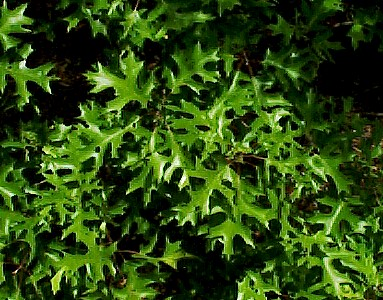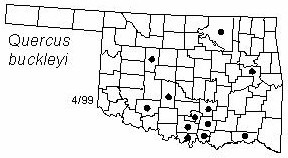
Small to medium tree to 15 m (50 ft) tall. Bark dark gray, smoothish, furrowed into ridges on lower trunk and older branches. Twigs slender, grayish or brownish, glabrous, ending in a cluster of small egg-shaped grayish or brownish buds. Leaves alternate, elliptical or obovate, 6-12 cm (2.4-4.8 in) long and 5-10 cm (2-4 in) wide,deeply divided into 5-9 (usually 7) lobes which are usually broadest toward the tip and end in several bristle-tipped teeth, shiny dark green above, pale green with tufts of hairs in vein axils below, turning brown or red in fall. Fruits are acorns maturing in the second year, egg-shaped, 12-18 mm (0.5-0.7 in) long and 8-14 mm (0.3-0.6 in) wide with a more or less shallow cup covering 1/3-1/2.
Distribution: Native to an area from southcentral Texas to northcentral Oklahoma.
Habitat: rocky slopes and ridges, most abundant in the Arbuckles and Wichitas.
Comment: Texas oak is usually too small for sawlogs. It often produces large numbers of acorns, which are valuable as food for wildlife. Quercus is the ancient classical name for the European oaks; buckleyi honors American geologist and botanist S. B. Buckley.
NWI status: none
Distribution in Oklahoma: 
BACK
NEXT
RETURN TO INDEX
Last update: 9/16/99
 Go to Oklahoma Biological Survey Home Page
Go to Oklahoma Biological Survey Home Page
 Disclaimer
Disclaimer